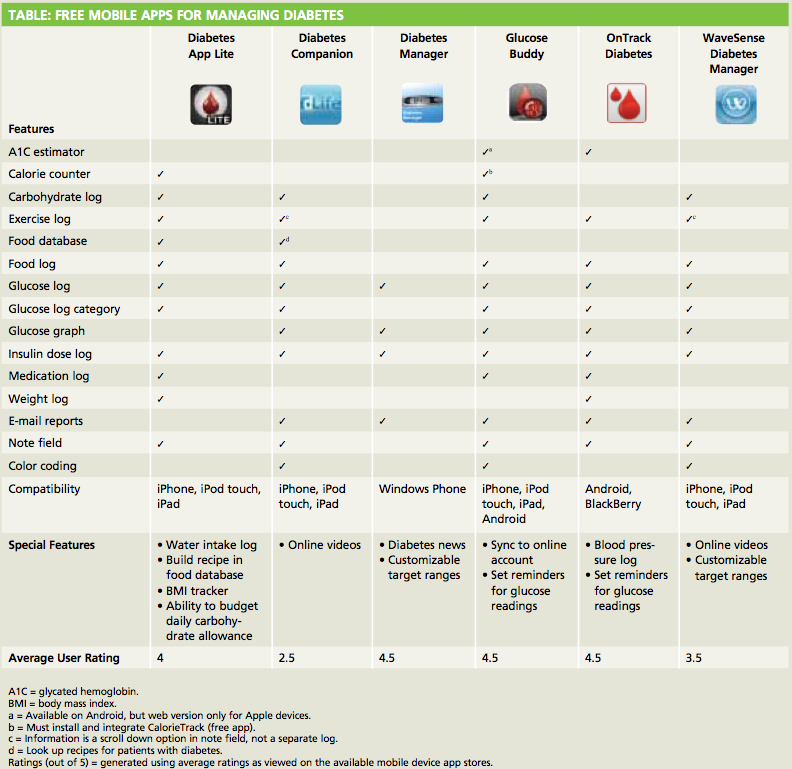Publication
Article
Pharmacy Times
Diabetes Apps: Impacting Patients' Lives
A new wave of mobile applications encourages disease management on the go.


A new wave of mobile applications encourages disease management on the go.
Diabetes is a complex condition which requires various treatment and education strategies to achieve goals beyond glycemic control.
Key pillars in the management of diabetes include maintaining adequate lifestyle habits, diabetes self-management education, and prevention of diabetic complications.1 A core issue facing today’s patients living with diabetes is the daunting task of tracking countless glucose readings, lab tests, medication compliance, insulin dosing, appointments, dietary intake, exercise activities, and recommendations given by various health care providers.
In the age of the smartphone, numerous mobile applications have been and will continue to be developed to help patients manage diabetes. A recent survey showed that in the United States, approximately 45% of adults and 34% of young adults own a smartphone.2 The smartphone revolution provides an emerging opportunity for health care professionals to counsel patients on a new and potentially more effective method for electronically documenting essential health information.
A published clinical trial from Diabetes Care showed that patients with type 2 diabetes who received behavioral mobile coaching through the use of tracking medications, caloric intake, glycemic levels, and other management information, compared with usual care without mobile coaching, were more likely to experience greater decreases in glycated hemoglobin. The difference between groups was 1.2% over a 12-month period (P <0.001).3 While ongoing research is being conducted to determine the impact of electronic documentation on clinical outcomes, the importance of getting patients involved is likely to improve decision support among health care providers.
The table shows frequently used apps and key features contained within each app to aid in the management of diabetes. These apps were selected based on their ability to perform specific functions for diabetes care, were given high ratings from users, and are free for public use. Various paid apps are also available, although patients may choose to demo one or more free versions first to help them discover their preferred user interface and become acquainted with electronic documentation. Before recommending these apps, health care professionals should be familiar with the terminology and functionality unique to these applications, as detailed below.

There are 3 major focus areas of the mobile apps for diabetes:
Glucose Control
All of the mobile apps have a method for tracking glucose lab values. The apps allow users to specify the time and date of the glucose value and select the relationship to meals (eg, before or after breakfast) as well as physical activity (eg, before or after physical activity). Another possible function is the ability for each patient to enter specific glucose levels in which they feel they are most likely to experience symptoms of hypo or hyperglycemia. Some apps may allow entry of custom glucose goals, contain graphs of glucose trends over a certain time period, and record A1C levels.
Medication Log
Another key feature of some of these apps is its ability to track medication compliance. Patients can log the time of day that insulin injections, oral medications, and other dosage forms were administered. For quick entry, some apps also have a built-in preset dropdown selection for various types of insulin. A note field is included in most of the medication logs, which could be helpful for patients wishing to document any additional information beyond medication administration.
Food Log
Patients with diabetes are counseled on the importance of a well-balanced diet to achieve adequate glucose control. Some apps provide easy tracking of how many calories, carbohydrates, and other nutrients are consumed in any given meal. Others have a built-in food database for patients to simply select which foods they ate at any particular time of day. A selection can be made from an alphabetical list of foods, which then yields an approximate carbohydrate value based on the nutrition label. This can subsequently be added to the food log. Alternatively, apps may simply allow for patients to arbitrarily enter foods consumed and estimate carbohydrate grams for each meal.
Miscellaneous Features
Other functions contained in some apps are the ability to enter notes in various fields, export data (eg, Excel) for future retrieval, e-mail reports to health care providers, and track weight and blood pressure parameters. Patients who decide to upgrade to paid apps may find additional tools such as medication and appointment reminders, broader dropdown selections, educational notes, insulin calculators, and other specialized features.
Krisy-Ann Thornby is an assistant professor of pharmacy practice and Drug Information Center co-coordinator at Palm Beach Atlantic University, Gregory School of Pharmacy. Nicole Edquist is a PharmD candidate at the Gregory School of Pharmacy.
References
- American Diabetes Association. Standards of medical care in diabetes--2013. Diabetes Care. 2013;36(suppl 1):S11-S66.
- Smartphone Research: Infographic. Our Smartphone Habits. http://pewinternet.org/Infographics/2012/Our-Smartphone-Habits.aspx. Accessed January 3, 2013.
- Quinn CC, Shardell MD, Terrin ML, Barr EA, Ballew SH, Gruber-Baldini AL. Cluster-randomized trial of a mobile phone personalized behavioral intervention for blood glucose control. Diabetes Care. 2011;34(9):1934-1942.







